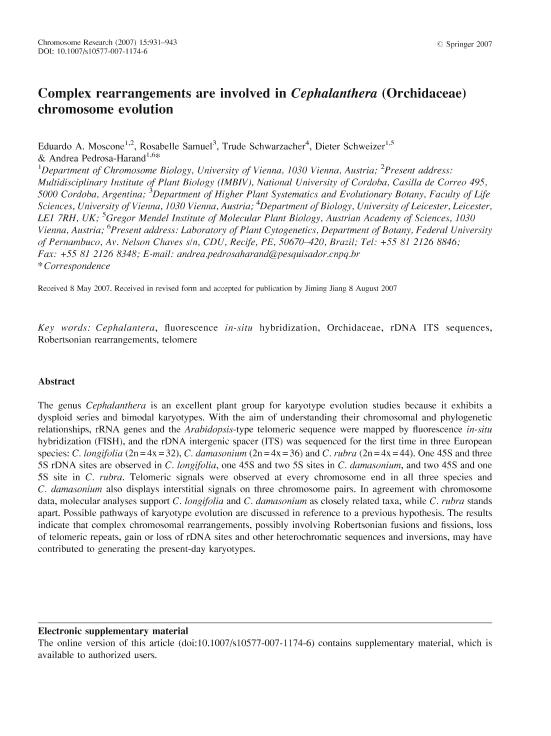Artículo
Complex rearrangements are involved in Cephalanthera (Orchidaceae) chromosome evolution
Moscone, Eduardo Alberto ; Samuel, Rosabelle; Schwarzacher, Trude; Schweizer, Dieter; Pedrosa-Harand, Andrea
; Samuel, Rosabelle; Schwarzacher, Trude; Schweizer, Dieter; Pedrosa-Harand, Andrea
 ; Samuel, Rosabelle; Schwarzacher, Trude; Schweizer, Dieter; Pedrosa-Harand, Andrea
; Samuel, Rosabelle; Schwarzacher, Trude; Schweizer, Dieter; Pedrosa-Harand, Andrea
Fecha de publicación:
12/2007
Editorial:
Springer Netherlands
Revista:
Chromosome Research
ISSN:
0967-3849
e-ISSN:
1573-6849
Idioma:
Inglés
Tipo de recurso:
Artículo publicado
Clasificación temática:
Resumen
The genus Cephalanthera is an excellent plant group for karyotype evolution studies because it exhibits a dysploid series and bimodal karyotypes. With the aim of understanding their chromosomal and phylogenetic relationships, rRNA genes and the Arabidopsis-type telomeric sequence were mapped by fluorescence in-situ hybridization (FISH), and the rDNA intergenic spacer (ITS) was sequenced for the first time in three European species: C. longifolia (2n = 4x = 32), C. damasonium (2n = 4x = 36) and C. rubra (2n = 4x = 44). One 45S and three 5S rDNA sites are observed in C. longifolia, one 45S and two 5S sites in C. damasonium, and two 45S and one 5S site in C. rubra. Telomeric signals were observed at every chromosome end in all three species and C. damasonium also displays interstitial signals on three chromosome pairs. In agreement with chromosome data, molecular analyses support C. longifolia and C. damasonium as closely related taxa, while C. rubra stands apart. Possible pathways of karyotype evolution are discussed in reference to a previous hypothesis. The results indicate that complex chromosomal rearrangements, possibly involving Robertsonian fusions and fissions, loss of telomeric repeats, gain or loss of rDNA sites and other heterochromatic sequences and inversions, may have contributed to generating the present-day karyotypes.
Palabras clave:
Cephalantera
,
Orchidaceae
,
Fluorescence in Situ Hybridization
Archivos asociados
Licencia
Identificadores
Colecciones
Articulos(IMBIV)
Articulos de INST.MULTIDISCIPL.DE BIOLOGIA VEGETAL (P)
Articulos de INST.MULTIDISCIPL.DE BIOLOGIA VEGETAL (P)
Citación
Moscone, Eduardo Alberto; Samuel, Rosabelle; Schwarzacher, Trude; Schweizer, Dieter; Pedrosa-Harand, Andrea; Complex rearrangements are involved in Cephalanthera (Orchidaceae) chromosome evolution; Springer Netherlands; Chromosome Research; 15; 7; 12-2007; 931-943
Compartir
Altmétricas



